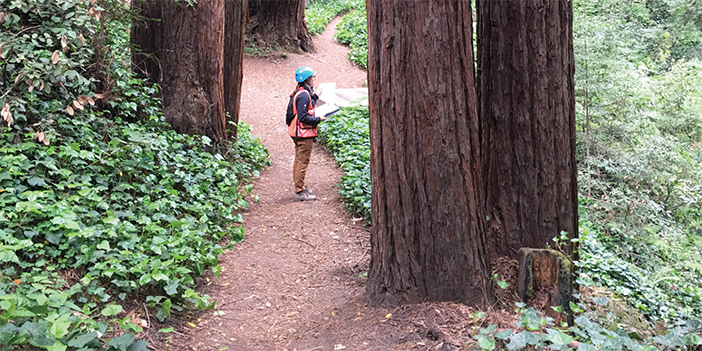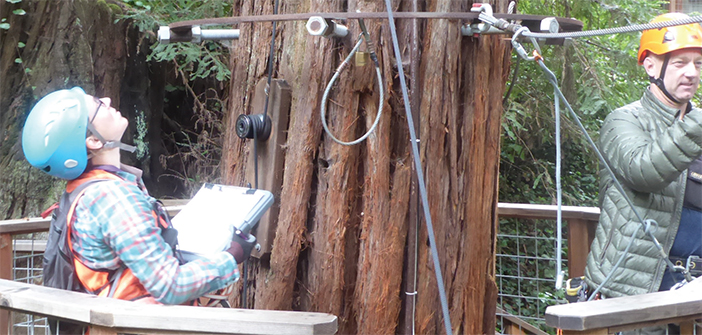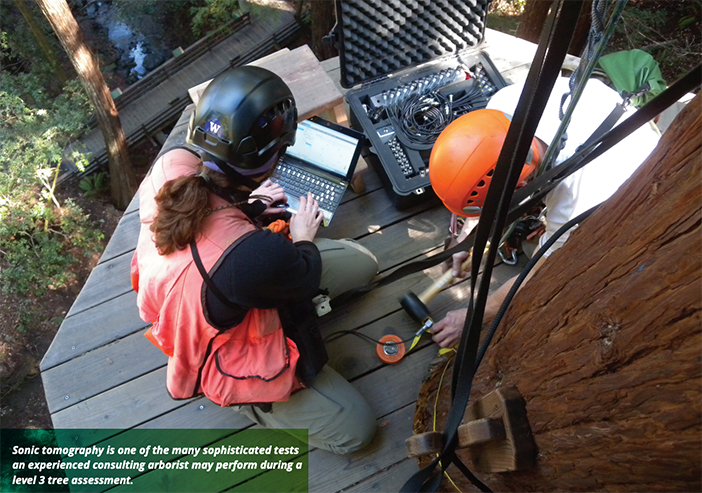Although trees pose a generally very low risk to people and facilities, stuff happens. Aerial adventure operators need to be proactive—not reactive—about tree health in order to minimize risk. This requires actively paying attention to your trees and having them regularly inspected and assessed by a qualified arborist.
Thinking through potential tree threats allows managers to make adjustments, such as tree pruning and cabling or moving or reinforcing facilities, to reduce risk. Staff doing daily course inspections should be trained to observe trees at a basic level and to report any changes to their supervisor (See “Reading the Trees,” API Summer 2021). Inspections by a qualified arborist should also be a component of the management plan for every site where trees are present.
Arborist inspections should happen at least once per year. For seasonal operations, inspections are recommended after closing to plan off-season maintenance and before opening to ensure everything made it through the winter and is safe to open for business.

Walking the grounds of the Redwood Sky Walk, Calif., performing a level 1 assessment, which includes visually
scanning the trees to identify any significant issues.
THREE LEVELS OF ASSESSMENT
When professional arborists inspect trees, there are three levels of assessment that can be considered, progressing from simple to complex. All three levels require knowledge of how trees grow within their environment, of the characteristics of individual tree species, and of the impact of human activities near trees. Not every arborist has this skill set, so it is important to ask about your arborist’s qualifications and the types of assessments they regularly perform.
Here, we’ll outline the three levels of tree assessment to help you gain an understanding of what each involves and so you can better determine if an arborist is qualified. With this knowledge, you can ask arborists simple questions like, “What level of assessment do you recommend for these trees?” or “What types of tree assessment have you done on adventure courses in the past?” and understand and evaluate the responses.
Caution: Don’t confuse a free bid for tree work by a commercial arborist with an assessment conducted by an experienced consulting arborist. Free bids can lead to recommendations for unnecessary tree management or lack vital information about a serious tree condition, for example. An assessment by a consulting arborist, on the other hand, will be more thorough. Consulting arborists typically charge by the hour and may also charge fees for the use of testing equipment or samples sent out for lab analysis.
LEVEL 1
A level 1 assessment provides an indication of the general conditions of a forested site. This level of assessment is often used for power lines, checks of urban tree collections after a storm, or any other situation where a large number of trees must be evaluated. On an aerial adventure course, a level 1 assessment is appropriate for identifying possible tree issues within range of the course trees and elements.
What? A level 1 is a visual scan of the trees surrounding the course. An arborist will take a short look at your trees, usually from one aspect, and identify significant issues such as the development of leans, broken branches targeting the course, or stem decays. Based on the issues identified, the assessor will make recommendations to the operator for immediate management, monitoring, or further assessment.
When? This level of assessment should be done by an arborist prior to building a course, as a yearly inspection, and after major weather events. In addition, the arborist can train your staff to conduct internal level 1 assessments, allowing your team to identify issues that may need an arborist’s attention in between regular inspections.
LEVEL 2
Also called a basic assessment, a level 2 assessment allows an arborist to spend some time with each tree. Using visual assessment and basic tools, a level 2 assessment will uncover many facts about the way a tree is growing and identify conditions of concern visible from the ground or with minimal excavation around the root flare.
What? Most arborists will bring some of the following tools when carrying out a level 2 assessment: a diameter tape, a laser hypsometer and azimuth, a compass, a sounding mallet, a soil probe, a trowel or other digging tools, a mattock, chisels, hand pruners, a magnifying glass, binoculars, and a camera. These tools allow the arborist to evaluate trees with more depth than the purely visual level 1 assessment.
A TRAQ qualified arborist (Arborist Qualifications sidebar, next page) will generally also use a form (an ISA basic tree risk assessment form or equivalent) to record information about the tree(s) they are assessing. The form serves as a record for the operator of the arborist’s observations and measurements, but is not intended to be submitted to municipalities or in a formal report as the only source of tree risk assessment data.

Co-author Katherine Taylor conducting a level 2 assessment on a tree at Mt. Herman, Calif. She’s collecting data using visual inspection and basic tools to produce an effective evaluation of the tree’s health and stability.
Level 2 assessments require adequate time—at least 15-30 minutes per tree— and thus adequate budget. This level of inspection produces an effective evaluation of the health and structural stability of trees, and it will inform whether a risk assessment or level 3 assessment is needed.
When? This is the standard assessment an arborist would conduct when called out to examine a tree based on a concern or observation you have made. Level 2 assessments should be conducted on each course tree or potential course tree before design and construction, and every year as a part of normal management. Your arborist may also recommend a level 2 as a result of findings from a level 1 inspection they conducted on trees within range of the course.
ARBORIST QUALIFICATIONS
At minimum, your arborist should have an International Society of Arboriculture (ISA) arborist certification and the Tree Risk Assessment Qualification (TRAQ). More advanced arborists may also have an ISA Board Certified Master Arborist certification and an American Society of Consulting Arborists (ASCA) Registered Consulting Arborist (RCA) certification.
The TRAQ is intended to increase an arborist’s level of competence in assessing tree risk. TRAQ has been in place for six years. It is not a license to assess trees for risk, rather it is a syllabus that describes the assessment method and current arboricultural understanding and practices.
The TRAQ methodology for risk assessment is subjective and uses accepted international methods for risk assessment approved by the International Standards Organization (ISO). The TRAQ method uses two matrices—a likelihood of failure matrix and a risk rating matrix—to determine the level of risk for a particular tree. The method aims to safely preserve trees, so it is important that the risk assessor is experienced and knowledgeable enough to suggest arboricultural treatments or other actions that can be used to mitigate tree risk and bring a tree back from dangerous to acceptable levels.

As part of a level 3 assessment, co-author Scott Baker uses a micro-resistance drill to look at the tree’s growth rate and determine if there is any decay.
LEVEL 3
When the situation demands a higher level of information regarding tree stability or health, a level 3 assessment is called for. Level 3 assessments can be time consuming and require special equipment, training, and experience. Thorough assessments of this type are often required for high value trees or trees that are critical components of a course or facility.
What? A level 3 assessment provides details about the structural stability of a tree, any decays, pathogens, insects, pests, or nutrient deficiencies present, and possible issues with the soil that require management. Depending on the tree and the goal of the inspection, a level 3 assessment can include:
• Aerial inspection for evaluation of structural defects in the upper parts of trees.
• Detailed target analysis, which may include research into the use of the site and the condition of some of the target structures.
• Decay testing, including increment boring, drilling with a small diameter drill bit or micro resistance recording drill, single path sonic assessment, sonic tomography, electrical impedance tomography, and microscopic analysis for fungal species identification.
• Health evaluation, including tree ring analysis, shoot length measurement, detailed health and vigor analysis, and starch level assessment.
• Soil or tissue testing in cases where a nutrient deficiency or a pathogen is suspected.
• Root inspection and evaluation, including root and root collar excavations, root decay evaluations, and ground penetrating radar.
• Storm and wind load analysis, including a detailed assessment of the tree’s exposure and protection factors, computer-based estimations according to engineering models, and wind reaction monitoring over a defined interval. • Measuring, monitoring and assessing a change in trunk lean.
• Load testing using methods such as a hand pull test, a measured static pull test (aka standard integrated assessment), or measured tree dynamics.
When? An operator might seek a level 3 assessment when regulatory scrutiny is a factor. For example, during a level 3 inspection, an arborist could test support trees at the base and, if needed, at critical elevations using sonic tomography to provide the course owner with data about tree species characteristics like wood strength and tree health. This data is vital for engineers running numbers. It also allows building-code officials to be more certain that the trees are sound and stable.
Level 3 testing can also be used to monitor how a condition is progressing. Trees with decay columns can remain structurally stable for a long time and sometimes may even be appropriate for use as course trees depending on a variety of factors. A level 3 assessment can answer questions like: Is the pathogen or pest still present? Have the nutrient levels of the soil returned to normal? Is the tree producing new sound wood, or is the spread of decay outpacing the growth of new tissue?
The recommendation for a level 3 assessment typically emerges from a level 2 assessment. To determine whether you should follow through on a recommendation, consider whether the tree in question is a course tree or could impact the course in the event of a failure, and what the possible consequence of a failure could be.
While a level 3 assessment can be expensive, it can reduce costs—monetary and environmental—in the long-term. Jumping to conclusions based on a level 1 or 2 assessment that provided insufficient data might lead an operator to move a course element unnecessarily, or cut down a structurally stable tree, or remove a tree that’s health, disease, or insect problems could have been resolved with simple cultural management. In some cases, unneeded tree removal could result in further problems, like leaving the remaining trees more vulnerable to wind and weather events, increasing the risk of other failures.
Thus, it is important to make forest management decisions using factual, science-based information. There aren’t many arborists with the experience, knowledge, and equipment capable of this level of inspection, and only a highly qualified consulting arborist should perform level 3 work.
A NOTE ON RISK ASSESSMENT
An arborist may recommend a formal risk assessment after a level 3 or even a level 2 assessment. (Sometimes an arborist can take good measurements without advanced equipment or knows enough information based on the species of tree and decay present to make a recommendation for risk assessment without proceeding to a level 3.)
What? To determine the overall risk level of a tree, your arborist will consider: what the defect is; what kind of failure could occur as a result of the defect; how likely the failure is to occur over a given timeframe; what the tree or tree part would hit if it did fail (a nearby platform, a zip line, people using the course, a building, etc.); how often that target is there (people, cars, and animals all move); and what the consequences to the target would be if the tree or tree part hit it.
This information is put into a matrix that determines the risk level. At which point, your arborist will make management recommendations to reduce risk, which may include: cutting the tree down; pruning the part that might fail; making the tree a snag; monitoring the tree for some condition, like lean; or even moving the target—perhaps a bench or picnic tables—to another location.
INSPECTION PLANNING
How should you incorporate tree assessments on your site into your management operations? How much time should you spend on your trees? Here are some recommendations to help you decide what kind of assessments (and therefore what kind of specialist) you might need:
• Staff course inspections:
– Conduct regular level 1 assessment with appropriately trained in-house staff to identify immediate management needs and when to call an arborist for help between regular inspections.
• Annual or bi-annual inspections by a qualified arborist:
– Conduct a level 1 assessment on trees within range of the course.
–Conduct a level 2 assessment of all course trees from the ground and platform.
• Arborist weather event inspections:
– Conduct a level 1 assessment of all course and surrounding course trees after major weather events.
• Arborist assessment prior to design and construction of a course:
– Conduct a level 1 inspection of all trees within range of the new course location.
– Conduct a level 2 inspection on all potential attachment trees.
– Conduct a level 3 assessment on course trees based on the outcome of the level 2 inspection to confirm structural stability, provide data for the engineering and build teams, and fulfill any permitting requirements.
• Arborist new or developing conditions assessment:
– Have a consulting arborist conduct a level 2 assessment on trees that your staff or a commercial arborist have identified as a concern.
– Have a consulting arborist perform level 3 testing of trees based on the outcomes of the level 2 assessment.
•Arborist tree risk assessments:
– Conduct risk assessments on trees within range of a course when the operator or staff have a concern or the arborist has identified significant defects.
The health of your trees is vital to the sustainability of your business and the safety of your staff and guests. Frequent inspection—at the right level— will help protect your business, people, and forest for the future.







